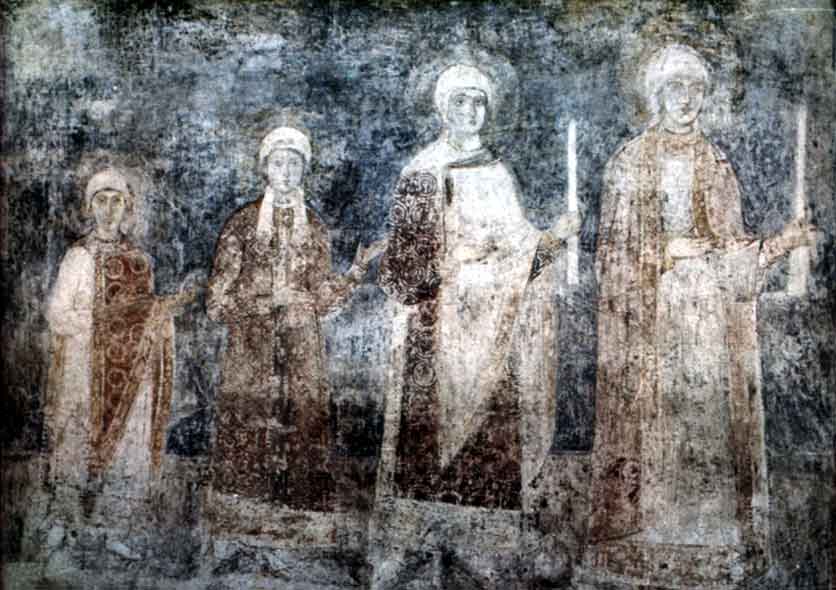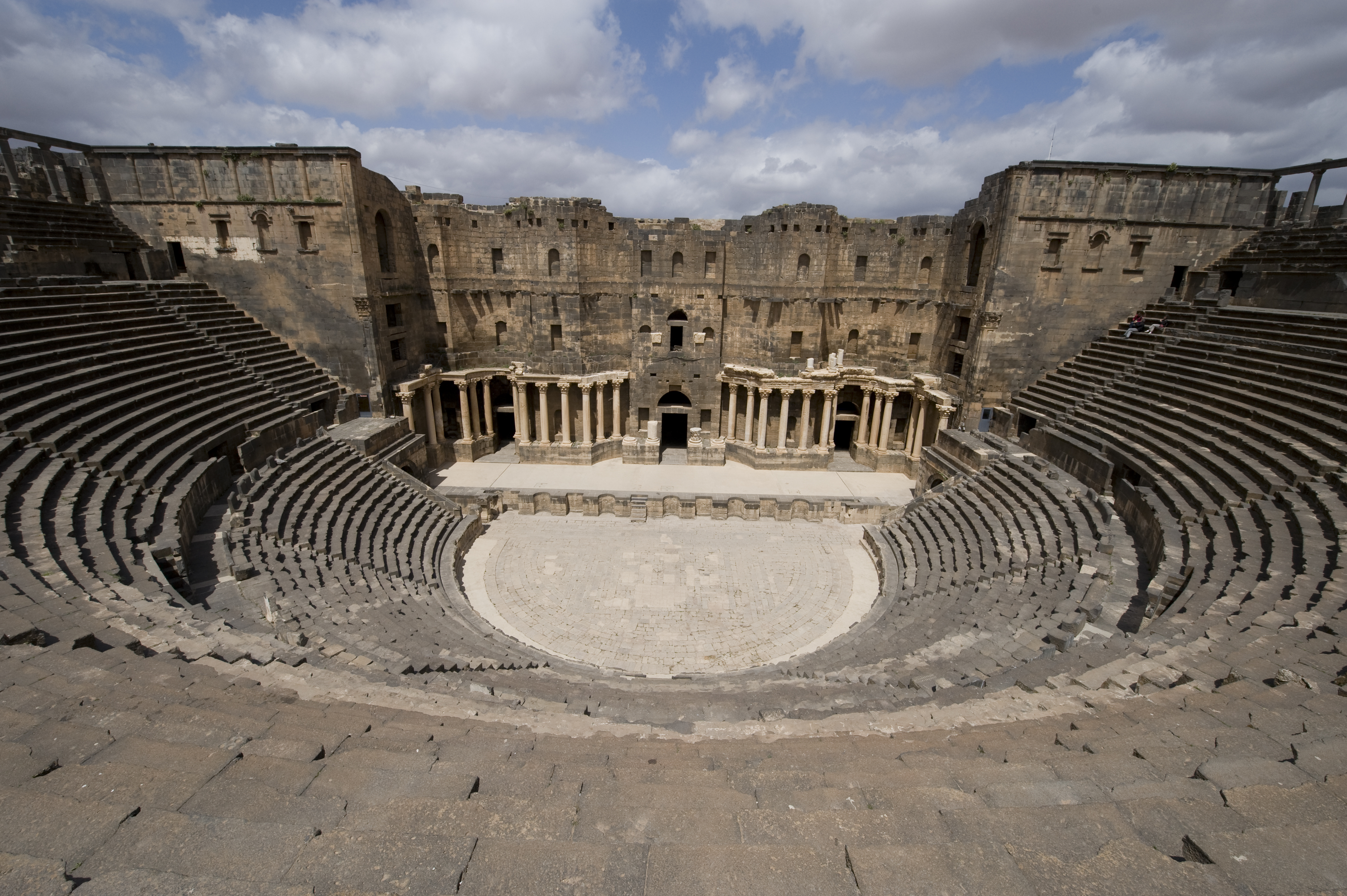|
October 4 (Eastern Orthodox Liturgics)
October 3 - Eastern Orthodox liturgical calendar - October 5 All fixed commemorations below celebrated on October 17 by Eastern Orthodox Churches on the Old Calendar. For October 4th, Orthodox Churches on the Old Calendar commemorate the Saints listed on September 21. Saints * Hieromartyr Hierotheus of Athens, first Bishop of Athens (1st century)October 4/17 Orthodox Calendar (PRAVOSLAVIE.RU). Συναξαριστής. 4 Οκτωβρίου '' ECCLESIA.GR. (H ΕΚΚΛΗΣΙΑ ΤΗΣ ΕΛΛΑΔΟΣ). * Venerable Theodore the Wonderworker, Bishop of |
Domnina, Berenice, And Prosdoce
Saint Domnina and her daughters Berenice (Bernice, Veronica, Verine, Vernike) and Prosdoce are venerated as Christian martyrs by the Roman Catholic and Eastern Orthodox Churches. The Diocletianic or Great Persecution was the last and most severe persecution of Christians in the Roman Empire. In 303, the emperors Diocletian, Maximian, Galerius, and Constantius issued a series of edicts rescinding Christians' legal rights and demanding that they comply with traditional religious practices. In the winter of 302, Galerius urged Diocletian to begin a general persecution of the Christians. Diocletian was wary, and asked the oracle of Apollo at Didyma for guidance. The oracle's reply was read as an endorsement of Galerius's position, and a general persecution was called on February 23, 303. The persecution failed to check the rise of the Church. By 324, Constantine was sole ruler of the empire, and Christianity had become his favored religion. Although the persecution resulted in death ... [...More Info...] [...Related Items...] OR: [Wikipedia] [Google] [Baidu] |
Bishop Of Bologna
The Archdiocese of Bologna is a Latin Church ecclesiastical territory or archdiocese of the Catholic Church in Northern Italy. The cathedra is in the cathedral church of San Pietro, Bologna. The current archbishop is Cardinal Matteo Zuppi, who was installed in 2015. The Archdiocese of Bologna is a metropolitan archdiocese and has three suffragan dioceses within its ecclesiastical province: the Diocese of Imola, the Diocese of Faenza-Modigliana, and the Archdiocese of Ferrara-Comacchio. History A detailed list of the various governments that have ruled Bologna is provided by Giovanni Battista Guidicini. In 1527, the Holy See became the absolute ruler of Bologna, and was represented by a ''Legatus a latere'' and a Vice-Legate. On 22 February 1530, Pope Clement VII crowned the Emperor Charles V as Holy Roman Emperor in Bologna, the last such event in history. The bishopric of Bologna was founded in the 3rd century. Originally it was a suffragan (under the supervision) of ... [...More Info...] [...Related Items...] OR: [Wikipedia] [Google] [Baidu] |
Petronius Of Bologna
Saint Petronius ( it, San Petronio) (died ca. 450 AD) was bishop of Bologna during the fifth century. He is a patron saint of the city. Born of a noble Roman family, he became a convert to Christianity and subsequently a priest. As bishop of Bologna, he built the Church of Santo Stefano. Life The only certain historical information we possess concerning him is derived from a letter written by Bishop Eucherius of Lyon (died 450–455) to Valerianus, and from Gennadius' ''De viris illustribus''.Kirsch, Johann Peter. "St. Petronius." The Catholic Encyclopedia Vol. 11. New York: Robert Appleton Company, 1911. 18 November 2021 Eucherius writes that the holy Bishop Petronius was then renowned in |
Ingegerd Olofsdotter Of Sweden
Ingegerd Olofsdotter of Sweden, also known as Irene, Anna and Saint Anna (1001 – 10 February 1050), was a Swedish princess and a Grand Princess of Kiev. She was the daughter of Swedish King Olof Skötkonung and Estrid of the Obotrites and the consort of Yaroslav I the Wise of Kiev. She is venerated as a saint in the Eastern Orthodox Church. Ingegerd or Saint Anna is often confused with the mother of Saint Vladimir “the Enlightener” of the Rus. This is mainly because Ingegerd and Yaroslav also had a son named Vladimir. However, Saint Vladimir was the father of Ingegerd’s husband Yaroslav I “the Wise”, thus making her Saint Vladimir’s daughter-in-law. Saint Vladimir was the son of Sviatoslav and Malusha. Life Ingegerd was born a princess in the court of King Olof Skötkonung. In 1015, after Olaf II of Norway assumed the throne as King of Norway, he proposed a royal marriage alliance. In 1016, noblemen of both countries tried to arrange a marriage betwe ... [...More Info...] [...Related Items...] OR: [Wikipedia] [Google] [Baidu] |
Novgorod
Veliky Novgorod ( rus, links=no, Великий Новгород, t=Great Newtown, p=vʲɪˈlʲikʲɪj ˈnovɡərət), also known as just Novgorod (), is the largest city and administrative centre of Novgorod Oblast, Russia. It is one of the oldest cities in Russia, being first mentioned in the 9th century. The city lies along the Volkhov River just downstream from its outflow from Lake Ilmen and is situated on the M10 federal highway connecting Moscow and Saint Petersburg. UNESCO recognized Novgorod as a World Heritage Site in 1992. The city has a population of At its peak during the 14th century, the city was the capital of the Novgorod Republic and was one of Europe's largest cities. The "Veliky" ("great") part was added to the city's name in 1999. History Early developments The Sofia First Chronicle makes initial mention of it in 859, while the Novgorod First Chronicle first mentions it in 862, when it was purportedly already a major Baltics-to- Byzantium station on t ... [...More Info...] [...Related Items...] OR: [Wikipedia] [Google] [Baidu] |
Vladimir Of Novgorod
Vladimir Yaroslavich (russian: Владимир Ярославич, Old Norse ''Valdamarr Jarizleifsson''; 1020 – October 4, 1052) reigned as prince of Novgorod from 1036 until his death. He was the eldest son of Yaroslav I the Wise of Kiev by Ingigerd, daughter of king Olof Skötkonung of Sweden. In the state affairs he was assisted by the voivode Vyshata and the bishop Luka Zhidiata. In 1042, Vladimir may have been in conflict with Finns, according to some interpretations even making a military campaign in Finland. In the next year he led the Russian armies against the Byzantine emperor Constantine IX. He predeceased his father by two years and was buried by him in St Sophia Cathedral he had built in Novgorod. His sarcophagus is in a niche on the south side of the main body of the cathedral overlooking the Martirievskii Porch. He is depicted in an early twentieth-century fresco above the sarcophagus and on a new effigial icon on top of the sarcophagus. The details of his d ... [...More Info...] [...Related Items...] OR: [Wikipedia] [Google] [Baidu] |
Bostra
Bosra ( ar, بُصْرَىٰ, Buṣrā), also spelled Bostra, Busrana, Bozrah, Bozra and officially called Busra al-Sham ( ar, بُصْرَىٰ ٱلشَّام, Buṣrā al-Shām), is a town in southern Syria, administratively belonging to the Daraa District of the Daraa Governorate and geographically part of the Hauran region. According to the Syria Central Bureau of Statistics (CBS), Bosra had a population of 19,683 in the 2004 census. It is the administrative center of the ''nahiyah'' ("subdistrict") of Bosra which consisted of nine localities with a collective population of 33,839 in 2004. Bosra has an ancient history and during the Roman era it was a prosperous provincial capital and Metropolitan Archbishopric, under the jurisdiction of Eastern Orthodox Patriarchate of Antioch and All the East. It continued to be administratively important during the Islamic era, but became gradually less prominent during the Ottoman era. It also became a Latin Catholic titular see and the ... [...More Info...] [...Related Items...] OR: [Wikipedia] [Google] [Baidu] |
Peter Of Capitolias
Peter of Capitolias was an 8th-century Christian saint. He was born in Capitolias, in what is today Jordan, married and became the father of three children. After the death of his wife, he became a monk and, according to some traditions, was later consecrated bishop of Bosra. He was executed by stoning in Bosra for criticizing Islam. His feast day is January 13 or October 4. Before his execution, he was successively interrogated by the governor of the Jund al-Urdunn district, Umar ibn al-Walid, his deputy Zur'a and finally Caliph al-Walid I Al-Walid ibn Abd al-Malik ibn Marwan ( ar, الوليد بن عبد الملك بن مروان, al-Walīd ibn ʿAbd al-Malik ibn Marwān; ), commonly known as al-Walid I ( ar, الوليد الأول), was the sixth Umayyad Caliphate, Umayyad ca ... ().Hugh N. Kennedy''The Byzantine and Early Islamic Near East'' Ashgate Publishing 2006, p. 333. References {{saint-stub 8th-century Christian saints People executed for blasphemy 715 death ... [...More Info...] [...Related Items...] OR: [Wikipedia] [Google] [Baidu] |
Saint Amun
Ammon, Amun ( cop, Ⲁⲃⲃⲁ Ⲁⲙⲟⲩⲛ), Ammonas ( grc-gre, Ἀμμώνας), Amoun (), or Ammonius the Hermit (; el, Ἀμμώνιος) was a 4th-century Christian ascetic and the founder of one of the most celebrated monastic communities in Egypt. He was subsequently declared a saint. He was one of the most venerated ascetics of the Nitrian Desert, and Athanasius of Alexandria mentions him in his life of Anthony the Great. Life Pushed into marriage by his family at the age of 20, he managed to persuade his bride to take a vow of chastity together with him by the authority of Paul's Epistle to the Corinthians.Socr. ''Hist. Eccl.'' iv. 23 They lived together this way for 18 years, when at her wish, they parted, and he retired to Scetis and Nitria, to the south of Lake Mareotis, where he lived 22 years, visiting his sister-wife twice a year. She had founded a convent in her own house. He cooperated with Anthony and gathered his monks under his direct supervision, t ... [...More Info...] [...Related Items...] OR: [Wikipedia] [Google] [Baidu] |
Paul The Simple
St. Paul the Simple of Egypt (d. ca. 339) was a hermit and disciple of St. Anthony the Great. St. John, the Abbot of Sinai wrote "Paul the Simple was a clear example for us, for he was the rule and type of blessed simplicity." Though contemporaries, he is not to be confused with St. Paul of Thebes, regarded as the First Hermit. The account of his life is found in Palladius of Helenopolis ''De Vitis Patrum'' 8,28 and Tyrannius Rufinus ''Historia Eremitica'' 31. Life Paul was a farmer who, at the age of sixty, discovered that his beautiful wife was having an affair and so left her to become a hermit. Approaching St. Anthony, Paul indicated his desire to become a monk. Anthony responded by saying it would be quite impossible for a man of sixty years to adopt such a radical life style. He instead encouraged Paul to be content with the life of being a thankful and pious labourer. Paul was unsatisfied with this answer and responded by pleading his will to learn. Anthony said that if he ... [...More Info...] [...Related Items...] OR: [Wikipedia] [Google] [Baidu] |
Ephesus
Ephesus (; grc-gre, Ἔφεσος, Éphesos; tr, Efes; may ultimately derive from hit, 𒀀𒉺𒊭, Apaša) was a city in ancient Greece on the coast of Ionia, southwest of present-day Selçuk in İzmir Province, Turkey. It was built in the 10th century BC on the site of Apasa, the former Arzawan capital, by Attica, Attic and Ionians, Ionian Greek colonists. During the Classical Greece, Classical Greek era, it was one of twelve cities that were members of the Ionian League. The city came under the control of the Roman Republic in 129 BC. The city was famous in its day for the nearby Temple of Artemis (completed around 550 BC), which has been designated one of the Seven Wonders of the Ancient World. Its many monumental buildings included the Library of Celsus and a theatre capable of holding 24,000 spectators. Ephesus was recipient city of one of the Pauline epistles; one of the seven churches of Asia addressed in the Book of Revelation; the Gospel of John may have b ... [...More Info...] [...Related Items...] OR: [Wikipedia] [Google] [Baidu] |



